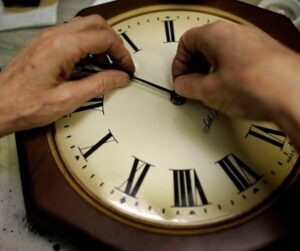Last year the U.S. Senate surprised everyone and unanimously passed the Sunshine Protection Act, which would have kept the country permanently on daylight savings time. Not many bills get the thumbs up from every senate member, so there was a sense that switching clocks twice a year had met its final Waterloo. But then the measure went to the House, where it died. So here we are again, ready to do the time change tango tomorrow, March 12, leaving many to wonder if the business of clock changing will ever come to an end.
Massachusetts Senator Ed Markey (D) has been the point man for keeping daylight savings time (DST) permanently. He recently asserted, “The sun doesn’t have any enemies.” But he may be wrong about that. Sleep doctors maintain an extra hour of sunshine can mess with human circadian rhythms.
The American Medical Association is in favor of eradicating daylight savings time altogether. Neurologists and Cardiac specialists argue that shifting to an extra hour of daylight results in “a higher risk of cardiac problems such as heart attack, atrial fibrillation-related hospital visits, and an increase in ischemic stroke,” according to the Wall Street Journal. As well, shifting the time can cause a lower cognitive performance level, resulting in more car accidents, according to a study by John Hopkins and Stanford University. Conducted just before the turn of the century, their research revealed fatal car accidents rose approximately 5% on the Monday following the spring forward. What appears unclear in all this research is whether the negative effects of DST are a result of the “change” or a result of living with an extra hour of sunlight.
Spring Forward – The Politics of Sleep
Americans do not favor adjusting their clocks twice a year, but they can’t seem to agree on what to do about it. In 2019 an AP-NORC poll revealed that 31% of those surveyed favored staying on daylight savings time all year. That number went up in 2022, according to a Monmouth University poll which showed that 44% want to keep daylight savings time. Only 35% say we should keep springing forward and falling back an hour yearly.

(Photo by Joe Raedle/Getty Images)
Such division has kept the pro and anti-clock-switching lobby busy, forcing many representatives from different parts of the country to form geographical coalitions. Sen. Wendell Ford (D-KY) said, “It is just each coast that is in favor of this. The core of this great country apparently is not.” However, it isn’t quite as simple as Ford makes it out to be. Only Hawaii and Arizona have chosen not to participate in the bi-annual clock-changing ritual. Both states stay on standard time.
At the forefront of the bipartisan permanent DST effort are Senators Marco Rubio (R-FL), Ed Markey (D-MA), and Patty Murray (D-WA). Despite strong support in the senate from both sides of the political aisle, movers and shakers in the nation’s capital aren’t optimistic about finding a solution to the time change conundrum because key congressional committee leaders that need to approve the legislation remain ambivalent.
Still, many contend that changing the clocks twice a year is more than just a pain in the neck. Some say it throws their sleep schedule off, which causes adjustments in their prescription medication schedule, not to mention a general malaise in the mornings and evenings. But if the political tea leaves are an indication, the lack of a unified effort to either keep daylight savings or chuck it all together has not yet coalesced into a movement with enough strength to stop the clocks from being changed twice a year.
Do you have an opinion about this article? We’d love to hear it! If you send your comments to [email protected], we might even publish your edited remarks in our new feature, LN Readers Speak Out. Remember to include the title of the article along with your name, city, and state.
Please respect our republishing guidelines. Republication permission does not equal site endorsement. Click here.

